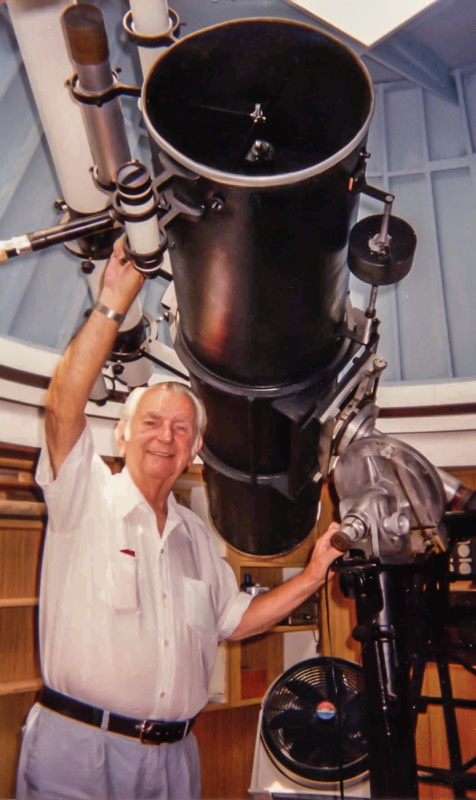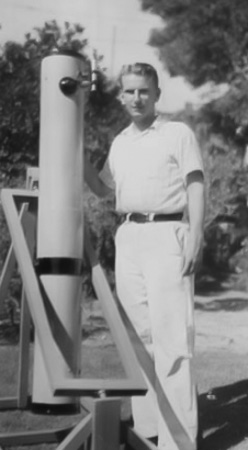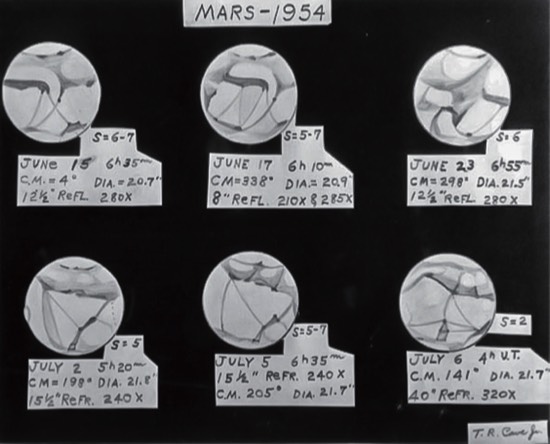Thomas Roland Cave III (1923−2003)
Richard McKim and Tom Dobbins
British Astronomical Association
Richard McKim and Tom Dobbins
British Astronomical Association
Tom Cave of Long Beach, California, will best be remembered as a telescope-maker. For three decades Tom’s firm, the Cave Optical Company, turned out tens of thosands of mirrors for both the amateur and professional markets. However, Tom was also a keen planetary observer. RJM first met him at a BAA meeting at Savile Row, London in 1986 when he turned up seemingly out of the blue with a bunch of Mars drawings in his pocket.
Tom was born in Kansas City, Missouri, on 1923 February 3. His parents were Thomas Roland Cave II and Edna Catherine Wyrick Cave. He spent the first six years of his life in Pittsburgh, Kansas. In 1931, the family moved to Hollywood, California. His father had taken him to the Adler Planetarium in Chicago when he was seven years old, and thus began his lifelong love affair with astronomy. A further move, this time to Long Beach, came in 1934, and it was there that he became involved with the Excelsior Telescope Club. In those days, southern California was the centre for amateur telescope making in the USA, so the family’s move there was a very fortunate one in that respect.
At the age of eleven Tom ground and polished a 6-inch (15cm) plate glass telescope mirror. Together with Ramsden eyepieces by John Mellish, this became his first Newtonian telescope. Davina Cave, one of his daughters, writes: ‘During his junior year of high school at Long Beach Poly, his family moved to the house here at 265 Roswell Avenue. Dad was on the football team at Poly, so he remained there, even though Wilson (the big rival school) was less than a mile from his home, and graduated in 1941 (a semester early, I might add).’
Following graduation, Tom went to work for Jimmy Herron at the Herron Optical Company in Los Angeles. Tom was also observing with larger and larger instruments, and in 1940 built an observatory at home. He be- gan to correspond with other American amateurs, such as Ed Martz, Walter H. Haas, Hugh M. Johnson and Frank M. Vaughn. They pooled their planetary observational work, and Haas wrote it up in Popular Astronomy (USA; now defunct) and the Journal of the Royal Astronomical Society of Canada. After the war this group would act as a nucleus for the fledgling Association of Lunar and Planetary Observers, and its members would write for its journal, Strolling Astronomer.
Tom was born in Kansas City, Missouri, on 1923 February 3. His parents were Thomas Roland Cave II and Edna Catherine Wyrick Cave. He spent the first six years of his life in Pittsburgh, Kansas. In 1931, the family moved to Hollywood, California. His father had taken him to the Adler Planetarium in Chicago when he was seven years old, and thus began his lifelong love affair with astronomy. A further move, this time to Long Beach, came in 1934, and it was there that he became involved with the Excelsior Telescope Club. In those days, southern California was the centre for amateur telescope making in the USA, so the family’s move there was a very fortunate one in that respect.
At the age of eleven Tom ground and polished a 6-inch (15cm) plate glass telescope mirror. Together with Ramsden eyepieces by John Mellish, this became his first Newtonian telescope. Davina Cave, one of his daughters, writes: ‘During his junior year of high school at Long Beach Poly, his family moved to the house here at 265 Roswell Avenue. Dad was on the football team at Poly, so he remained there, even though Wilson (the big rival school) was less than a mile from his home, and graduated in 1941 (a semester early, I might add).’
Following graduation, Tom went to work for Jimmy Herron at the Herron Optical Company in Los Angeles. Tom was also observing with larger and larger instruments, and in 1940 built an observatory at home. He be- gan to correspond with other American amateurs, such as Ed Martz, Walter H. Haas, Hugh M. Johnson and Frank M. Vaughn. They pooled their planetary observational work, and Haas wrote it up in Popular Astronomy (USA; now defunct) and the Journal of the Royal Astronomical Society of Canada. After the war this group would act as a nucleus for the fledgling Association of Lunar and Planetary Observers, and its members would write for its journal, Strolling Astronomer.

Tom Cave in his home observatory in Long Beach, CA, with his 32cm (12.5-inch) Newtonian, 1994. Photograph by Richard McKim
Proposed by Johnson, Tom joined the BAA on 1942 March 30, and contributed drawings of the perihelic opposition of Mars in 1941, some of which eventually appeared in print in the Section Memoir. Mars was already his favorite celestial object. It was just as well that he specialized in planetary work, for in later years only the brightest stars could be seen from his garden due to severe light pollution. Tom also assembled an impressive planetary astronomy library at his home. This began as a teenager when he purchased (for $2) Lowell’s first Mars book, published in 1895.
Following the entry of the USA into World War II, Tom joined the US Army. (He recalled going into the army with Robert Mitchum, who would later achieve fame in Hollywood.) While stationed in England awaiting D-Day, he was sometimes able to attend BAA meetings at Burlington House. He served in the 4th US Infantry Division as a combat medic, going over with the Normandy landings. He saw harrowing action in the Battle of the Bulge, where he acquired his lifelong habit of smoking cigarettes. Tom earned two Purple Hearts, the first for shrapnel wounds received during an artillery barrage near Metz, and the second for injuries suffered to his right foot when a half-track ran over it during the fording of the Rhine in 1945. The latter incident occurred under shellfire on the famous Ludendorff Bridge at Remagen, and the injury would limit the amount of walking Tom could do comfortably in his later years. Optical work was not entirely forgotten during the war: he once made eyeglasses for General Omar Bradley!
On 1944 August 25, under Bradley’s orders, General Leclerc’s 2nd French Armoured Division entered Paris from the west at dawn, and the 4th US Infantry Division attacked from the south. By 8.30 am the Americans stood in front of Notre Dame. After the liberation of the city Tom lost no time in obtaining a day pass to visit the nearby Meudon Observatory. Speaking no French he nevertheless managed to gain entrance to see the ‘Grande Lunette’ – the 83cm refractor – and to meet veteran astronomer F. Baldet. He had hoped to meet Baldet’s colleague, the great E. M. Antoniadi, but it transpired that Antoniadi had died earlier in the year.
When Tom returned home, he went back to Herron Optical and attended classes in optical engineering at the University of Southern California, stopping just six units short of his degree to open his own business (at his father’s suggestion). Thus the Cave Optical Company was born in 1950 December. Not long afterwards, Tom met Sylvia Millicent Clanton at a church singles gathering, and they married on 1953 June 27. They would have two daughters. Tom was also heavily involved with the early ALPO, which was founded by Walter Haas in 1947. Haas writes: ‘Tom was the first Venus Recorder of the ALPO and later served for a time as Assistant Mars Recorder. It was inevitable that he should provide, at a special price, the optics for my 12.5-inch (32cm) Newtonian, my principal telescope since 1954.’

A very young Tom Cave pictured with his first Newtonian reflector (15cm) in 1937. Photo by Tom Dobbins
Cave Optical may have had a modest be- ginning in a converted garage, but it grew rapidly, benefiting from a quickly acquired high reputation and (at that time) a lack of competition. One of the many opticians recruited to grind and polish mirrors was the renowned lunar observer Alika Herring. Another employee, Dick Norton, has written the early history of the company in Sky & Telescope for 1994 August. The company’s main business was to make long-focus ‘Astrola’ Newtonians, but it also turned out Cassegrains, primary mirrors for Questars and optics for the US military. Norton writes that over the lifespan of the business, ‘Cave and his workers had produced more than 53,000 telescope mirrors and 15,000 complete telescopes.’ Indeed, Cave had pioneered the mass-production of telescopes. And with a shop in Long Beach it was inevitable that there should be some famous walk-in customers: actors John Wayne and Richard Widmark were just two of a long list. Unfortunately, in early 1979 Tom became seriously ill with kidney disease, and his absence from the workshop and a sequence of other events led to the demise of the company. Recovering later, Tom accepted an offer from Hughes Aircraft to head their optical department; later still he worked for Perkin−Elmer for a time. Tom retired from business in 1988, and was then able to devote much time to observation.
It would be an understatement to say that Tom was a great story teller: he had a seemingly inexhaustible supply of anecdotes about astronomers and – above all – other opticians. He would reminiscence about the Normandy campaign, the work of telescope- maker John Mellish, observing Mars at Lowell Observatory with E .C. Slipher (on several occasions from 1948 onwards), nights at the coudé focus of the Mount Wilson 100- inch in 1956 with R. S. Richardson on a night of super-seeing, nights at Table Mountain Observatory viewing Mars with Chick Capen, and many other tales. He told RJM that one of his most satisfying optical projects was the 18-inch (45cm) mirror made for the Ford Observatory, near Table Mountain, California. Certainly it gave excellent images of the impact scars on Jupiter when we used it together in 1994 following the ‘great comet crash’. The tale of Tom’s visit to Lowell Observatory in 1994 with RJM formed the subject of the latter’s BAA Presidential Address for that year, though it is not mentioned there how we ran out of petrol in the middle of the Mohave desert!
It would be an understatement to say that Tom was a great story teller: he had a seemingly inexhaustible supply of anecdotes about astronomers and – above all – other opticians. He would reminiscence about the Normandy campaign, the work of telescope- maker John Mellish, observing Mars at Lowell Observatory with E .C. Slipher (on several occasions from 1948 onwards), nights at the coudé focus of the Mount Wilson 100- inch in 1956 with R. S. Richardson on a night of super-seeing, nights at Table Mountain Observatory viewing Mars with Chick Capen, and many other tales. He told RJM that one of his most satisfying optical projects was the 18-inch (45cm) mirror made for the Ford Observatory, near Table Mountain, California. Certainly it gave excellent images of the impact scars on Jupiter when we used it together in 1994 following the ‘great comet crash’. The tale of Tom’s visit to Lowell Observatory in 1994 with RJM formed the subject of the latter’s BAA Presidential Address for that year, though it is not mentioned there how we ran out of petrol in the middle of the Mohave desert!
Tom’s own telescope used for much of his career was an f/6 32.5cm (12.8-inch) Newtonian. (Oddly, it was not carried by one of his own company’s mountings, but by a Cooke equatorial, purchased secondhand in England in 1944. Tom shipped it to the States at the end of the war ‘when I knew I’d be around to use it.’) Throughout the 1990s and during 2001 Tom continued to observe Mars regularly,and occasionally the other planets, with this instrument. To the last, he remained very much a visual observer. We recall his total lack of interest in CCD cameras. ‘They take all the fun out it’, he always said.
In his last few years, Tom wrote some optical notes which it is hoped will appear in book form after editing by TD. He had also hoped to write a book about Mars, but the project was never realized. During an observational career spanning more than six decades, Tom Cave was honored with many awards, including the Bruce Blair medal of the Western Amateur Astronomers, and the Walter Haas Award of the ALPO.
By late 2002 Tom’s health was failing, and following a bout of pneumonia and complications from diabetes he passed away on 2003 June 4. Sylvia Cave had died in 1990. He is survived by his two daughters, Davina and Vanessa, and two grandsons. At Tom’s memorial service in Long Beach TD was able to present an appreciation of Tom’s contributions to astronomy. Many of Tom’s friends from high school, the Los Angeles Astronomical Society, the Excelsior Telescope Club, the ALPO and other organisations were present. We will let Walter Haas have the last word: ‘Those of us who knew him personally will remember him more as a delightful and informative friend and companion. Indeed, if you phoned Tom to discuss an astronomy problem, you were likely to receive more information about astronomy and astronomers of his acquaintance in the next 30 minutes than you could absorb.’
Family details were helpfully provided by Davina Cave, and were essential in the writing of this appreciation.
In his last few years, Tom wrote some optical notes which it is hoped will appear in book form after editing by TD. He had also hoped to write a book about Mars, but the project was never realized. During an observational career spanning more than six decades, Tom Cave was honored with many awards, including the Bruce Blair medal of the Western Amateur Astronomers, and the Walter Haas Award of the ALPO.
By late 2002 Tom’s health was failing, and following a bout of pneumonia and complications from diabetes he passed away on 2003 June 4. Sylvia Cave had died in 1990. He is survived by his two daughters, Davina and Vanessa, and two grandsons. At Tom’s memorial service in Long Beach TD was able to present an appreciation of Tom’s contributions to astronomy. Many of Tom’s friends from high school, the Los Angeles Astronomical Society, the Excelsior Telescope Club, the ALPO and other organisations were present. We will let Walter Haas have the last word: ‘Those of us who knew him personally will remember him more as a delightful and informative friend and companion. Indeed, if you phoned Tom to discuss an astronomy problem, you were likely to receive more information about astronomy and astronomers of his acquaintance in the next 30 minutes than you could absorb.’
Family details were helpfully provided by Davina Cave, and were essential in the writing of this appreciation.
Richard McKim and Tom Dobbins
British Astronomical Association
We wish to thank Robert and Tom for their contribution to this website.

Mars in 1954. A set of previously unpublished drawings by Tom Cave of Mars at its close opposition in 1954. The 15.5-inch (39cm) OG is the Clark refractor of Washburn Observatory, and the 40-inch (102cm) OG is that at Yerkes Observa- tory. (BAA Mars Section archives; one of three sheets contributed by Cave.

